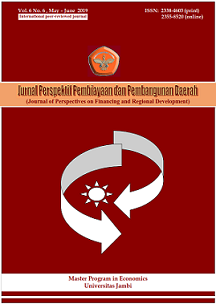The effect of inflation, US bond yield, and exchange rate on Indonesia bond yield
DOI:
https://doi.org/10.22437/ppd.v6i6.6853Abstract
Indonesia sovereign bonds are investment graded bonds, therefore, it will have global exposure and it will be more interlinked with global market condition. The purpose of this research is to examine the impacts of US bond yield, exchange rate, and inflation on Indonesian bond yield. Our result conclude that based on Vector Error Correction Model there are long run causality from inflation, US 10 year bond yield, and USD/IDR exchange rate to Indonesia 10 year bond yield. There are also short-run causality from inflation and US 10 year bond yield to Indonesia 10 year bond yield. Based on impulse response function, Indonesia 10 year bond yield respond permanently to changes in US 10 year bond yield. Based on Granger causality we also reveal that inflation and US 10 year bond yield can cause Indonesia 10 year bond yield. US 10 year bond yield has a larger impact than inflation when it comes to affecting Indonesia 10 year bond yield
Downloads
References
Akinsola, F. A. (2018). Essay on spillovers from advanced economics (AE) to emerging economics (EM) during the global financial crisis. Journal of Financial Economic Policy, 10(1), 38-54.
Arshad, H., Muda, R., & Osman, I. (2017). Impact of exchange rate and oil price on the yield of sovereign bond and sukuk: Evidence from Malaysian capital market. Journal of Emerging Economies & Islamic Research, 5.
Belke, A., Dubova, I., & Volz, U. (2016). Long-term interest rate spillovers from major advanced economies to emerging Asia. ADBI Working Paper, No. 705.
Christiansen, C. (2007). Volatilityâ€spillover effects in European bond markets. European Financial Management, 13(5), 923-948.
El Ouadghiri, I., Mignon, V., & Boitout, N. (2016). On the impact of macroeconomic news surprises on Treasury-bond returns. Annals of Finance, 12(1), 29-53.
Espinosa-Torres, J. A., Gomez-Gonzalez, J. E., Melo-Velandia, L. F., & Moreno-Gutiérrez, J. F. (2016). The international transmission of risk: Causal relations among developed and emerging countries’ term premia. Research in International Business and Finance, 37, 646-654.
Fisher, I. (1930). Theory of interest: as determined by impatience to spend income and opportunity to invest it. Augustusm Kelly Publishers, Clifton.
Fong, T., Li, K. F., & Sze, A. (2016). Measuring Spillovers between the US and Emerging Markets. HKIMR Working Paper No.08.
Gadanecz, B., Miyajima, K., & Shu, C. (2014). Exchange rate risk and local currency sovereign bond yields in emerging markets. BIS Working Paper 474.
Hsing, Y. (2015). Determinants of the government bond yield in Spain: a loanable funds model. International Journal of Financial Studies, 3(3), 342-350.
Manurung, A. H., Sihombing, P., Siregar, H., & Santosa, P. W. (2017). Determinan Yield Curve Surat Utang Negara. Jurnal Keuangan dan Perbankan, 15(1).
Schaeffer, I., & Ramirez, M. D. (2017). Is there a Long-Term Relationship among European Sovereign Bond Yields? Business and Economic Research, 7(1), 68-86.
Yuliawati, D., & Suarjaya, A. G. (2017). Pengaruh Umur Obligasi, Tingkat Suku Bunga, Dan Inflasi Pada Imbal Hasil Obligasi Pemerintah Di BEI. E-Jurnal Manajemen Universitas Udayana, 6(11), 6187-6215.
Downloads
Published
How to Cite
Issue
Section
License
Copyright (c) 2019 Achlanudin Yusuf, Ahmad Danu Prasetyo

This work is licensed under a Creative Commons Attribution 4.0 International License.

















